 |
Festung Rothenberg
Schnaittach, Germany
|
|
 |
Constructed: 1729-1750
Used by: Germany
Conflict in which it participated:
War of the Austrian Succession
|
At the beginning of the 11th century, there was a little town called Rothenberg. It was close to a larger market town called Schaittach, which was (and still is) about twenty miles northeast of the major city of Nuremberg. All of these picturesque dorfs and bergs lie in the southern part of what is today Germany, more specifically in Bavaria.
Rothenberg and Schnaittach were very close to Bavaria's border with Franconia, a region named for the Franks that operated as its own semi-nation through the Middle Ages. Nuremberg was in fact an important Franconian city, and the little towns of our current interest lived under the constant threat of being swallowed up by the wicked Franks. |
 |
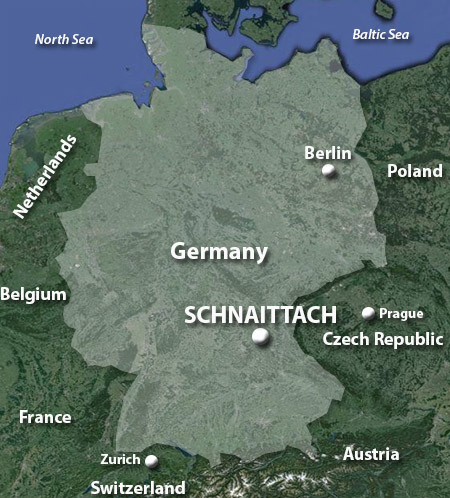 |
|
Will we go quietly into the night, wondered Dietrich von Wildenstein, the latest in a long line of noble Wildensteins, at the start of the 14th century? The answer was nein, and the result was the first fortification built on Rothenberg hill, to the east of Schnaittach, which was completed around 1330. This was probably a fairly rudimentary hill- or ring-fort, built to prevent any sneaky Franconian tentacles from wrapping around Schnaittach and snatching it away, whole.
The Wildensteins sold their fort to Bohemian king Charles IV (1316-1378) in 1360. Charles strengthened the position into a substantial border castle. This major defensive work, existing so close to a major Franconian city, became known as "the thorn in Nuremberg's side."
A confederation of 44 Frankish knights, the Ganerben, purchased what was by then know as Veste Rothenberg in 1478. They further strengthened the fort and made it their cool place to hang out when they wanted to be away from their wives, presumably. This brought the fort, and surrounding area, into a closer relationship with Nuremberg.
|
Rotenberg as it would appear in 1703, by Matthäus Marian, 1648. Click on it, it's huge. |
 |
The knights and their knightly offspring happily enjoyed the masculine camaraderie that can only be achieved by hiding from one's wife in a fort, for 150 years. Their bliss was interrupted thanks to the 30 Years' War (1618-1638), during which the Electorate of Bavaria (which was the governing body of Bavaria from 1623 until Napoleon (1769-1821) screwed everything up in 1806) commandeered Veste Rothenberg, sent the knights back to their shrewish wives, and occupied the fort.
Rothenstein went unscathed by the 30 Years' War, but was less fortunate during the War of the Spanish Succession (1701-1704). |
|
|
Weird Mutant Spanish King Charles II (1661-1700), the ultimate product of centuries of royal inbreeding, died heirless in 1700. He had ruled over a huge empire, and there were differing opinions as to whom should next rule the Spanish Empire. Somehow Bavaria managed to support the wrong side in the war that resulted from this characteristically European unpleasantness, for which Veste Rothenstein paid dearly.
|
Which was just as well, because it's high time we got to the starfort part of this story. The forces of Holy Roman Emperor Leopold I (1640-1705) collided with a Bavarian force at the little village of Krottensee, yet another little Bavarian dorf with which I'm forcing you to become slightly familiar, in the spring of 1703.
During the Battle of Krottensee, an anti-Bavarian wind blew powder smoke into the eyes of the Bavarians, temporarily blinding them. While the Bavarians were cursing and rubbing their eyes, the Holy Romans rolled right over them, put the village of Krottensee to the torch, and occupied nearby Veste Rothenberg.
|
 |
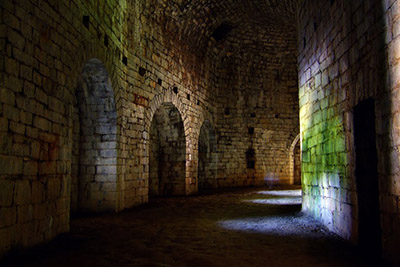 The casemates of Festung Rothenberg in their current form. The casemates of Festung Rothenberg in their current form. |
|
Long had Rothenberg been the thorn in Nuremberg's side: Now the residents of Nuremberg had an excellent opportunity to take out their smoldering frustration on the fort! Using the excuse that it was occupied by wicked Imperial troops, the residents of Nuremberg overran the fort and tore it to the ground. Did the soldiers of the Holy Roman Empire just stand aside and allow this to occur? Unclear. Whatever, by 1721 the last remains of Veste Rothenberg had been swept from the hilltop, and Rothenberg was finally a clean slate for proper starfortage.
|
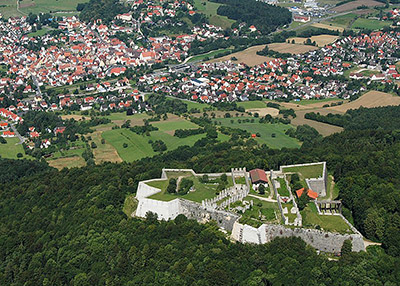 Thank heavens, it's finally a starfort. Festung Rothenberg watches over Schnaittach. |
 |
Construction of the starfort we see today began in 1729: The Electorate of Bavaria and Holy Roman Emperor Charles VII (1697-1745) footed the bill for this undertaking, agreeing that a fort in "the French style" was needed to protect the realm: A starfort.
Festung Rothenberg is also described as being built in "the Rococo style," which is dumb. Rococo was a style of art and architecture popular during the era in question, but starforts are not designed and built based on "playful, witty themes." Starforts are built to kill people outside of them, while simultaneously preventing the death of those on their inside.
|
|
|
Unless the distinctive shape of Festung Rothenstein was specifically chosen to look witty and playful. It's hard to say what was in the mind of a starfort engineer who may or may not have had Rococo pretentions in 1729.
Festing Rothenstein saw its only action before it was even completed, in 1744. All of Europe was yet again embroiled in a violent disagreement over whom should ascend to an empire's throne. And Bavaria, also yet again, managed to ally with the losing side of the War of the Austrian Succession (1740-1748).
|
Whomever came to Schnaittach to try their luck against Festung-in-Progress Rothenberg in 1744 (likely those Austrian busybodies), they were either so unimpressed that they turned around and walked away shaking their heads, or else so overawed that they collectively fell into the fœtal position and soiled themselves, because there seems to have been no effect on the fort whatsoever from this alleged clash of arms.
Festung Rothenstein was completed in 1750. It could support a garrison of 400, water for whom was at least partially provided by a "worm fountain," which sounds like a refreshing water source indeed. The Festung's walls were 50 feet high.
|
 |
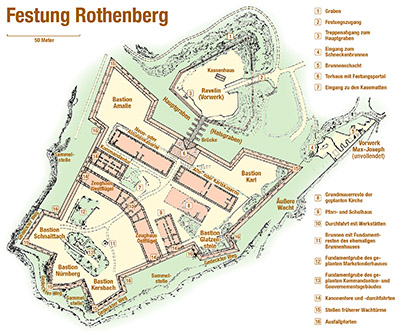 Festung Rothenberg. You read German, right? Excellent. Festung Rothenberg. You read German, right? Excellent. |
|
The ultimate goal of a starfort is to scare potential invaders away, and in this the Festung Rothenberg succeeded admirably. In 1806, the aforementioned Napoleon, master of Europe, dissolved the Holy Roman Empire. Bavaria became an independent kingdom, and annexed Franconia in 1815, once Napoleon had been forcibly sent off to his final vacation home on Saint Helena. Festung Rothenberg was used as a Bavarian prison for the next 20 years.
|
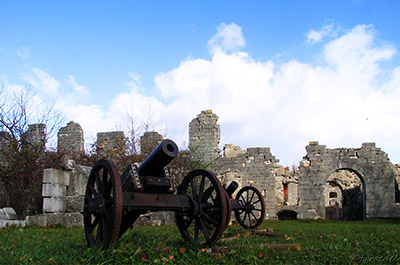 Two completely functional guns at the Festung today, which the local cannibals somehow missed. Thanks, T. Groedel! |
 |
In 1838, Bavarian King Ludwig I (1786-1868) determined that Festung Rothenberg, no longer anywhere near a contested border, was too expensive to maintain. Ludwig, also known as Ludwig the Vile Starfort-Hater, declared the demilitarization of Festung Rothenberg, and ordered its abandonment.
The last of the garrison left in 1841, and the fort was immediately "cannibalized" by the locals. Although this makes it sound as though other starforts cooked and ate Festung Rothenberg, one suspects it means that everything worth swiping inside the fort was unceremoniously carted away.
|
|
|
Our Festung was finally blessed with demonstrative military action in 1876, in the form of "explosive tests" on its ravelin. By this time the modern state of Germany had been forged from the many little kingdomlets left over from the Holy Roman Empire, and thus what might happen when a ravelin was blown up was of extreme importance. The German military determined that, surprisingly, when a ravelin is blown up it flies around in many pieces for a brief period, after which it's not there any more. Crucial information was obtained by this wanton ravelin destruction.
In 1892 the Local Beautification Association of Schnaittach was formed, which halted the cannibalization process and opened much of the fort to the public for tours. This coincided with the railroad connecting this part of Bavaria to the rest of Europe, and visitors came from far and wide. The Bavarian Administration of State-Owned Palaces, Gardens and Lakes took over Festung Rothenberg in 1966, and proceeded to pour millions of taxpayer's Deutschemarks into its restoration.
Today Festung Rothenberg is open for guided tours, with its lower casemates and tunnels locked up for several months of the year to protect a native colony of starfortbats. Some of the ravelin must still exist, as art and/or music events are held there in the summer months.
|
|
|
|
|
|
 |




